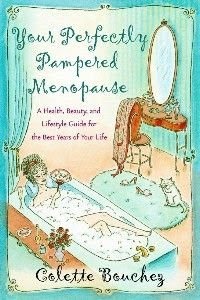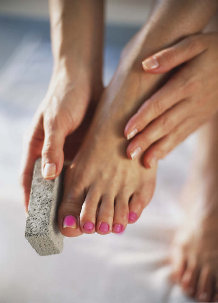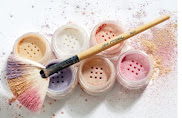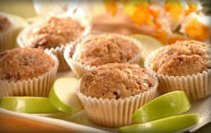 A new study suggests that the same shea butter oil which helps skin look younger may in fact alleviate the aches and pains of perimenopause and menopause. Here’s what you need to know!
A new study suggests that the same shea butter oil which helps skin look younger may in fact alleviate the aches and pains of perimenopause and menopause. Here’s what you need to know!
By Colette Bouchez
By now you've probably heard – or maybe even experienced first-hand - the power of Shea Butter to moisturize and repair damaged, aging skin. As an ingredient in many high-end moisturizers it’s use as an anti-aging skin preparation is nothing short of legendary.
Now, however, a growing body of research suggests that natural compounds found in the oils of the shea tree don’t just help you look good, they may, in fact, be what’s really bubbling out of Nature’s own fountain of youth – helping us to turn back the hands of time on a variety of age-related conditions, including those aches and pains of menopause.
And that, in fact, is precisely the finding of a brand new study to be published in January 2010 in the journal PhytoTherapy Research. Here doctors from the Australian Center for Complementary Medicine Education and Research (ACCMER) documented how a supplement containing therapeutic doses of shea oil has the ability to not only reduce incidence of midlife joint pain, but in some instances actually reverse of the underlying age-related damage behind the pain.
According to lead researcher Dr. Phillip Cheras, the secret lies in a natural chemical known as triterpene, found naturally in shea oil. When present in therapeutic levels it works, says Cheras, by reducing levels of an inflammatory compound known as TNF alpha – a natural substance made by the body when joints are under stress.
“Shea extract, the principal ingredient of FlexNow, [the supplement used in the study] has been shown to significantly reduce both joint pain and elevated levels of TNF alpha. There was also a significant decrease in the breakdown of cartilage in the osteoarthritis patients who received the shea extract”, says Cheras, an adjunct professor with NatMed Research at Southern Cross University of New South Wales.
And in fact the study found that after just 3 months of use, participants taking the FlexNow supplement not only experienced some 25% reduction in joint inflammation, they also experienced a reduction in several inflammatory “markers” associated with joint damage.
This may be particularly important for women over 35. Why? From this age forward we begin to gradually lose both estrogen and progesterone. While the drop in these hormones is most often associated with the traditional hot flashes and night sweats, doctors now know it also impacts how a woman perceives pain. Complicating matters further , when estrogen levels are high they keep a lid on the production of inflammatory chemicals particularly those linked to not just joint pain, but also heart disease, high blood pressure, even diabetes. So, without estrogen's protection, production of all these inflammatory chemicals can climb, writing us a "virtual prescription" for feeling more aches as we age.
Flex Now – Feel Good Later: The Study Specifics
The 15 week, randomized, double-blinded study involved 89 patients all of whom were diagnosed with osteoarthritis of the knees or hips. At the start of the study a variety of tests documented not only the degree of joint damage, but also a series of bio markers for inflammation of various types.
Each of the participants were then randomly selected to receive either daily treatment with SheaFlex 70 – a triterpene-rich extract of the African shea tree - or a placebo. Neither the patients nor the researchers knew who was taking the supplement or who was taking the placebo.
The result: In patients taking the FlexNow , those with the highest levels of inflammatory bio markers saw the most significant decrease in both inflammation and cartilage breakdown, as well as decreases in bone remodeling, when compared to those taking placebo.
More specifically, the FlexNow group experienced drop in levels of TNF-alpha of 23.9% vs 6% for the placebo group. Markers for cartilage destruction ( CTX-II) dropped by a whopping 29% in the FlexNow group, while in the placebo group, levels increased by 17.6%.
But it wasn’t only those most affected by inflammation who benefited. Indeed, the study showed that across the board rates of inflammatory chemicals dropped nearly 11% in all the study participants using the shea tree extracts – while inflammation in those taking the placebo increased by nearly 12%.
According to the researchers, their findings indicate that in patients with the highest levels of osteoarthritis biomarkers, “ SheaFlex70 [the active ingredient in FlexNow] demonstrated multiple beneficial activities consistent with slowing the disease process.”
But this wasn’t the first time the level of therapeutic doses of shea oil were proven to help. Indeed, previous studies on Flex Now found it also had a positive impact on inflammatory markers linked not only to joint pain, but those linked to high cholesterol and high blood pressure.
Reducing Inflammation Naturally: What Else You Can Do
While clearly using shea oil supplements is one way to reduce the inflammatory chemicals linked with all those aches and pains, there are other ways that, alone, or together with a supplement, can help you feel even better, ,faster. Here’s what the experts say you can try:
1. Lose a few pounds! Yes I know you’ve heard it all before – the extra weight puts pressure on joints that makes them feel worse. But what you might now know is that it’s not just lugging around those extra pounds that matter. Studies show that fat cells are a major producer of the inflammatory chemicals that not only increase joint pain, but can also increase your risk of diabetes, high blood pressure and heart disease. So, the fewer fat cells you have , the less inflammatory chemicals your body will produce – and yes, losing even 5 to 10 pounds can make a huge difference.
2. Eat less sugar and foods made with white flour. Not only are they higher in calories, but studies show both these ingredients can increase the inflammatory chemicals linked to osteoarthritis, heart disease and diabetes.
3. Eat less red meat. Like sugar and white flour, red meat also can increase the body’s production of inflammatory chemicals. In moderation red meat is a good source of protein – but eat too much and you’re setting your body up for a variety of pain-causing conditions.
4. Eat more fish – particularly salmon. It has among the highest rates of anti-inflammatory action of any food. Not only is it good for your joints, it’s great for your wrinkles! Eat it 3 times a week and see a noticeable improvement in 30 days.
5. Try yoga – or other non-stressing exercise, such as water sports. This can help reduce stress – which is a major contributor to the production of inflammatory chemicals in the body.
Colette Bouchez is the author of Your Perfectly Pampered Menopause and The Hot Flash Solution.
For more fabulous health and beauty tips for women over 40 visit RedDressDiary.com. Or for money saving beauty and style tips visit CheapChicDiary.com For more menopause advice visit YourMenopause.com.
Disclaimer: This article represents independent reporting of a new medical study. No payment or product samples were involved.
Copyright by Colette Bouchez 2009 - All Rights Reserved. In addition to US Copyright, the text of this RedDressDiary article is licensed under a Creative Commons Attribution-ShareAlike 3.0 License. All formatting and style elements of this page are not available under this license, and Colette Bouchez retains all rights in those elements.
Thursday, December 17, 2009
Shea Butter Oil: The New Fountain of Youth?
Monday, December 7, 2009
Fabulous Over 40: 10 Top Make Up Tips
 Whether you've just turned 40, you're heading down the pike towards 50 or a glam doll who's changing the world at 60, super celebrity make-up guru Michael Maron offers these 10 make up tips on how to look fabulous ... at any age!
Whether you've just turned 40, you're heading down the pike towards 50 or a glam doll who's changing the world at 60, super celebrity make-up guru Michael Maron offers these 10 make up tips on how to look fabulous ... at any age!
1. Avoid heavy foundation for over 40 skin, or powders, and always try to match what you use to your complexion color, rather than trying to add color to your face with a darker foundation or powder.
2. Don't use blushes or bronzers with a muddy or a brown tone. This tends to age skin and could make brown spots appear darker.
3. Avoid ultra light concealer under the eyes. This brings out puffiness and increases the look of the "tear trough" indentation under the eye. Instead, choose a color that matches your skin tone and blend well.
4. Always apply foundation before you apply concealer – you might not need as much as you think.
5. Avoid frosted, glittery, or very bright eye shadows – they'll accentuate wrinkly skin above the eye.
6. Do make lips look fuller by moisturizing and using lip liner – but make certain it's the same color as your lipstick. If you use colorless lipgloss, choose a lip liner that matches your own lip color and always blend it before adding the gloss. The look of the "heavy lip outline" is gone!
7. Do line eyes, but chose either a soft pencil or a liquid liner you can smudge slightly. A hard line around the eye is aging – so are clumps of heavy mascara, so keep it light.
8. Do not apply blush on the "apples" of the cheeks. As you age, the "apples" go south and color here ages the face. Instead keep blush higher on the face, the tops of the cheekbones is perfect for most women.
9. Avoid brow pencils that give a "shiny" or hard look. Instead opt for a powder or soft pencil – and always match your hair color.
10. Don't over powder your face – even the lightest products can age you if you use too much.
Having a hot flash? Your makeup could be making it worse! Visit HotFlashSolutions.com to learn more!
Wondering if mineral makeup is right for over 40 skin? Check out our free guide on mineral make-up and know for sure!
Copyright by Colette Bouchez 2009 - All Rights Reserved.
In addition to US Copyright, the text of this RedDressDiary article is licensed under a Creative Commons Attribution-ShareAlike 3.0 License. All formatting and style elements of this page are not available under this license, and Colette Bouchez retains all rights in those elements.
Monday, November 23, 2009
Swapping Hot Flashes for Fertility Drugs: Pregnancy Over 40
 Looking to trade in hot flashes and night sweats for diapers and pre-school? If you're over 40 and thinking about getting pregnant - here's some new hope and some sage advice.
Looking to trade in hot flashes and night sweats for diapers and pre-school? If you're over 40 and thinking about getting pregnant - here's some new hope and some sage advice.
By Colette Bouchez
Just the thought of getting pregnant at a time when most of your gal pals are talking hot flashes and leaky bladders can make the whole idea seem, well, rather daunting - if not totally out of the question.
But daunting as it may be, the reality is that today more and more women over 40 are deciding to trade in hormone replacement for fertility drugs and try for a pregnancy - some for the very first time.
For many of you already considering the idea - and for those who are actively trying to conceive - you no doubt have been told that "donor eggs" is your best chance. And, in fact, the more birthdays you've had since age 40, the more likely it is that you've been told donor eggs is your only chance for conceiving a healthy baby.
Well, those recommendations may soon change, thanks to the work of New York fertility expert Dr. John Zhang. Why? He has just helped a 49 year old patient get pregnant and give birth to a healthy, baby girl - using her own eggs!
The birth sets a new record and expands the scientific boundaries of assisted reproductive technology by a considerable margin. Prior to this, the old oldest woman to get pregnant using her own eggs was aged 45.
“For any loving couple, it's one of the greatest gift ….both the doctor and the patient should not give up easily just because of a woman's age,” Zhang recently told The New York Post, who first reported the story.
Now, if you're thinking this new birth might be an exceptional case, and not likely to be repeated, well, guess again! A second patient at Zhang's New Hope Fertility Clinic - also age 48 – is now pregnant with her own eggs as well. They were retrieved and frozen when she was 47.
How The Pregnancy Occurred
Although it now seems that using your own eggs - even at age 48 - is possible, it doesn't mean that doing so will be easy. Treatment of the 49 year old patient – who right now wishes to remain anonymous – took about two years, with procedures taking place almost every month. Zhang says egg production was not regular, and many of the eggs that were produced were either not viable – meaning they could not be fertilized – or once fertilized were too unhealthy to survive in the womb.
But with doctor and patient refusing to give up, eventually, they stroke “baby gold” ! An embryo that had been fertilized , then frozen, in September of 2008, was placed in the mother's uterus the following March. Nine months later, the fruits of their labors paid off with the birth of a strong, healthy baby girl!
The NY Post reports that following the birth the new mom emailed friends and family with the message : "She's beautiful and healthy....she's definitely the love of our lives!"
Zhang, who specializes in helping older women realize their parenting dreams , says that ironically, the key to his success is not to use more fertility drugs, but actually, to use less.
In fact, he reports that many of his most successful protocols use little to none of the stimulation drugs commonly used by other fertility centers to help women manufacture multiple eggs. This may be particularly important for older women since there has been some evidence that large doses of egg stimulating medications, along with increased estrogen, may be linked to an increased risk of breast cancer – particularly at a time when a woman's risk are naturally rising due to her age.
Although Zhang is definitely a pioneer in this respect, he is clearly not alone by taking the "natural " approach. Indeed, many doctors are now using various nutrition protocols, including special diets, as well as vitamin and other nutrient combinations to naturally increase not only egg production and ovulation, but also increase the success rate of IVF procedures. There are currently a number of key studies showing the positive impact that the right dietary and nutritional protocol can have.
Additionally, Dr. David Barad and Dr. Norbert Gleicher of the Center for Human Reproduction, located in New York and Chicago, have been using the natural supplement DHEA - short for Dehydroepiandrosterone - to help women over 40 get pregnant faster and easier and have reported increased fertility in this group. DHEA is a precursor compound that the body uses to make steroid hormones, including some that are directly involved in egg production.
To date, however, Dr. Zhang appears to have the only fertility expert with IVF success at age 49.
To read more about the various ways in which diet and nutrition has been clinically shown to increase pregnancy rates, as well as improve IFV outcomes, and learn more about DHEA visit FertilityDietGuide.com .
To learn more about minimal stimulation IVF and other new advances in getting pregnant faster at any age, visit www.GettingPregnantNow.org .
Copyright by Colette Bouchez 2009 - All Rights Reserved.
In addition to US Copyright, the text of this RedDressDiary article is licensed under a Creative Commons Attribution-ShareAlike 3.0 License. All formatting and style elements of this page are not available under this license, and Colette Bouchez retains all rights in those elements.
Saturday, November 14, 2009
Men, Canned Ravioli and Sexual Dysfunction
 A new study suggests that overexposure to chemicals found in thousands of consumer goods - including food and beverage containers – could be causing problems in the bedroom for men- and their partners. Here's what you need to know.
A new study suggests that overexposure to chemicals found in thousands of consumer goods - including food and beverage containers – could be causing problems in the bedroom for men- and their partners. Here's what you need to know.
If a group of Chinese researchers are right, you may want to keep your partner from snacking on canned ravioli and beer. The reason: You just might see the after-effects in the bedroom - and not in a good way.
Head researcher De-Kun Li recently told the Washington Post “ Critics dismissed all the animal studies saying 'Show us the human studies'; now we have a human study and this just can't be dismissed,” he said.
The result: The men who were exposed to the BPA were four times more likely to suffer from erectile dysfunction and seven times as likely to have difficulty with ejaculation.
Moreover, it didn't take long periods of exposure for the sexual problems to kick in. Indeed, men who worked in the factories only a matter of months appeared to be as affected as those who spent years being exposed to the chemical.
In other research it has been shown that men who have either erectile dysfunction or ejaculation problems also experience a higher rate of infertility – and now some researchers are wondering if the two problems aren't “chemically” connected.
BPA is a form of synthetic estrogen that is significant component in polycarbonate plastic.
Moreover, it's not just your partner who should be concerned. Indeed, studies show that BPA is also linked to an increased risk of breast cancer - in both younger an older women.
HOW MUCH BPA IS TOO MUCH BPA?
Indeed, Steven G. Hentges of the ACC recently told the press “ Although this study represents interesting information it has little relevance to average consumers who are exposed to trace levels of BPA,” he said.
Unfortunately, however, the “low dose” logic may not apply in this scenario. While traditional toxicology screens equate high doses of chemical contaminants with increased harm, specific tests on BPA show that lower doses may be even more toxic, simply because they “slip by” the body's natural defense system that would otherwise go to work detoxifying substances before they do harm.
In fact, in one study, low dose BPA exposure increased the risk of prostate cancer by 70% over high dose exposure, in lab animals.
Moreover, some experts contend that with so many products containing BPA, low level exposure may actually be chronic and continuing making it virtually impossible to calculate how much each man is getting – or how widespread that exposure might be among men already experiencing the symptoms represented in the study.
Because food and drink containers are such a large source of BPA, at least some of stink from this chemical cloud is hovers over the US Food and Drug Administration, which has been widely criticized for not regulating the chemical in the United States. Indeed, even their own scientific advisory committee voiced discontent over the fact that the FDA appears to ignoring more than 100 studies linking BPA to adverse health effects in animals including infertility, weight , behavioral changes, early -onset puberty, cancer and diabetes.
While the agency has reportedly pledged to re-examine the issue, to date, the FDA has maintains that BPA is safe. At the same time, the Canadian government has drafted legislation to prohibit the importation, sale and advertising of polycarbonate baby bottles that contain bisphenol A (BPA), and it has allocated 1.7 million dollars to further research the health effects of this chemical particularly in relation to food containers.
WHAT TO DO RIGHT NOW:
Copyright by Colette Bouchez 2009 - All Rights Reserved.
In addition to US Copyright, the text of this RedDressDiary article is licensed under a Creative Commons Attribution-ShareAlike 3.0 License. All formatting and style elements of this page are not available under this license, and Colette Bouchez retains all rights in those elements.
Tuesday, October 27, 2009
Study: Green Tea Reduces Holiday Stresses!
 Two brand new studies find green tea may be just what you need this holiday season!
Two brand new studies find green tea may be just what you need this holiday season!
By Colette Bouchez
More specifically, the study found that a specific compound found in green tea - epigallocatechin gallate (EGCG) – was able to enlarge the air space of the lungs of animals exposed to cigarette smoke, as well as increase the number of mucous producing cells – which help to keep lungs healthy. Animals fed other types of Chinese tea did not garner the same protection.
“These results indicate that increased levels of systemic oxidative stress after cigarette smoke exposure play an important role in the induction of lung damage,” wrote the researchers.
Further, they concluded that: “Chinese green tea may have the ability to suppress cigarette smoke-induced oxidative stress that leads to protection of lung injury.”
While the best way to keep lungs healthy is not smoke – and avoid spending time around those who do – if that's just not possible at the moment, you may gain some protection by adding some green tea to your diet.
The study was lead by Judith Mak from the University of Hong Kong.
Drink Tea – Reduce Stress – Be Happy!
What do you get when you add holidays to a year already filled with stressful events? Anxiety and plenty of it ! But now researchers say you just might cut your stress levels significantly and avoid many of the psychological stresses that abound this time of year, by taking some time out to sip green tea.
Indeed, in one large study published in The American Journal of Nutrition researchers suggest that natural chemicals found in green tea appear to carry some potent anti-anxiety effects. Indeed, a group of Japanese researchers looked at over 42,000 men and women including nearly 3,000 who were diagnosed with stress related conditions.
What they found : Those who drank at least 5 cups of green tea a day were far less likely to suffer with psychological stress when compared to those who drank 1 cup or less per day. In some instances the number of those affected by stress was reduced by as much as 20% among the tea drinkers.
Moreover, the results held true even after researchers figured in other influencing factors – such as age, sex, history of disease, BMI, alcohol consumption, smoking and diet.
Although this was the largest study ever conducted on the psychological effects of green tea, it dovetails with previous research suggesting that green tea may counter the effects of both physical fatigue and emotional stress.
Despite the size of the study, researchers say they aren't sure what components of green tea are responsible for the psychological lift – or if it's tea itself or the lifestyle associated with those who take the time out of their day to sip 5 cups of green tea.
But either way, putting a few relaxing moments into your day where you stop, take a breath and have a cup of green tea may have a big health payoffs, particularly in these stressful times. Studies show that chronic stress plays a role in heart disease, high blood pressure, diabetes and even some cancers.
For more round-the-clock good living advice visit RedDressDiary.com - Your Source for Health & Beauty Over 40!
Colette Bouchez is the co-author of the new book The New Fertility Diet Guide: Delicious Food Secrets To Help You Get Pregnant Faster At Any Age!
Copyright by Colette Bouchez 2009 - All Rights Reserved.
In addition to US Copyright, the text of this RedDressDiary article is licensed under a Creative Commons Attribution-ShareAlike 3.0 License. All formatting and style elements of this page are not available under this license, and Colette Bouchez retains all rights in those elements.
Sunday, October 11, 2009
Why A Woman's Heart Should NEVER Be Broken!
By Colette Bouchez
A woman’s heart should never be broken … but sometimes, it just is.
No, the villain isn’t that philandering boyfriend or nasty ex-husband. It’s heart disease - the number one threat to a woman’s heart, and her life.
In fact while heart disease used to be pretty much a man’s domain, you may be surprised to learn that today more than half of the deaths from heart attack - some 52% - occur in women, reports the US Centers For Disease Control (CDC).
And if you think it’s just our Mums and Grandmums who are at risk, here’s an even bigger shocker: According to the CDC, heart disease is the third leading cause of death in women aged 25 to 44.
I thought that might get your attention - because it sure got mine!
But the good news is there is something we can all do about it - and bring out our inner RedDress fashionista in the process!
First, take steps to reduce your personal risk of heart disease - by watching your weight, getting regular exercise, cutting down on the junk food and cutting out cigarettes.
Next, be super aware of the symptoms of heart attack, which in women, not only include chest pain, but sometimes pain in the upper back or upper stomach, and an unyielding sense of fatigue. If you - or any woman you know - is experiencing these symptoms, seek medical attention right away! Don’t wait - and insist on a workup for heart disease!
And third: Design a fabulous red evening or cocktail dress!
Indeed, Campbells Soup in conjunction with American Heart Association’s Go Red For Women Heart Disease campaign are once again sponsoring a spectacular Address Your Heart Red Dress Design Contest - with a ton of money going to the American Heart Association’s Go Red For Women Heart Disease Awareness campaign - and a grand prize that will knock your socks off - red or not - going to one spectacular winner!
To enter all you need do is fill out a short form, then submit a drawing of your fabulous red dress design - anything from a simple pencil scribbling to an elaborate computer generated work of art is fine! Just describe a few of the details (like fabric and embellishments) and you’re on your way!
 In mid November Project Runway’s Tim Gunn and his staff of design mavens will pick 3 of your fabulous Red Dress design entries, and they will be created by a top design firm, professionally photographed and put on display for public vote. (Just visit RedDressDiary.com after November 6th for more news, pictures of the finalist’s dresses and links where you can cast your vote!)
In mid November Project Runway’s Tim Gunn and his staff of design mavens will pick 3 of your fabulous Red Dress design entries, and they will be created by a top design firm, professionally photographed and put on display for public vote. (Just visit RedDressDiary.com after November 6th for more news, pictures of the finalist’s dresses and links where you can cast your vote!)But here’s the really great part: For every vote that’s cast, Campbells Soup will donate $1.00 to the American Heart Association’s Go Red For Women Movement - the premier fundraising and awareness raising campaign for women and heart disease - until a whopping 625 thousand bucks are raised for the cause!
PLUS: If you win the contest you ( and your spectacular red dress! ) will be on the arm of Tim Gunn strutting down the Red Carpet at the absolute most spectacular, star-studded Red Dress Red Carpet Event sponsored by Woman’s Day Magazine, in February 2010!
So, if you love your Mum, your sister, your Grandma, your best friend - if you love RedDressDiary or if you just love to WEAR RED , help show the world that a woman’s heart should never be broken! Join the contest, join the fun and help the cause - and together we can beat heart disease!
To learn more about how to join the contest and submit your design visit RedDressDiary.com and click the Attention All RedDress Fashionista's link on the top left sidebar!
And visit RedDressDiary 24/7 for the lastest health, beauty and style news for women over 40!
Copyright by Colette Bouchez 2009 - All Rights Reserved. In addition to US Copyright, the text of this RedDressDiary article is licensed under a Creative Commons Attribution-ShareAlike 3.0 License. All formatting and style elements of this page are not available under this license, and Colette Bouchez retains all rights in those elements.
Monday, October 5, 2009
Study: New Super Chocolate Beats Heart Disease
 A new study is the first to show that even those at high risk for heart disease can benefit from chocolate. Not but all chocolate is alike! Read on to learn more...
A new study is the first to show that even those at high risk for heart disease can benefit from chocolate. Not but all chocolate is alike! Read on to learn more...
By Colette Bouchez
Love chocolate? Okay, silly question! Well now you have a new reason to really, really love chocolate! A new study reveals that natural compounds found in some types of cocoa can not only help reduce your risk of heart disease, they do so even if you have high risk factors – including high blood pressure, diabetes and obesity.
That's the finding of a new study to be published in an upcoming issue of The American Journal of Clinical Nutrition. Here, scientists from The University of Barcelona in Spain report that chocolate containing up to 495 mg of polyphenols (a type of antioxidant nutrient) can reduce levels of inflammatory compounds that promote development of heart disease .
“Our results suggest that regular consumption of nutritional doses of cocoa may have an effect on all initial phases of the atherosclerotic process in subjects at high risk of CHD,” write the researchers.
The study is among the first human trials to prove the power of chocolate can make a difference even in those at high risk for heart disease including patients with diabetes, high blood pressure, and high cholesterol, as well as those who are obese or who smoke.
How Chocolate Protects Your Heart
Increasingly researchers are discovering that one of the reasons factors such as cigarette smoking or a high fat diet lead to heart disease is via the promotion of inflammatory chemicals - natural compounds produced by the body in response to any type of assault.
According to experts from the American Heart Association, these inflammatory chemicals not only contribute to the formation of plaque – the material that clogs blood vessels – but also the development of blood clots. Indeed, research shows that nearly every step involved in the development of heart disease involves some type of inflammatory response.
Now, the new study shows that chocolate rich in a natural compound known as polyphenols – found primarily in dark chocolate or cocoa – may interfere with the production of some of the chemicals that kick off the inflammatory response. And therein lies it's protective qualities.
“These anti-inflammatory effects may contribute to the overall benefits of cocoa consumption against atherosclerosis,” conclude the researchers.
This effect, they say, includes a dramatic reduction in natural body chemicals which would otherwise cause a chain reaction of events that culminate in an increase in inflammation in the lining of blood vessels
How The Chocolate Study Was Done
The research involved 42 people, averaged age 70, all of whom had significant high risk factors for heart disease. This included folks who were smokers and/or had high blood pressure, diabetes, obesity, high cholesterol , or a strong family history of heart disease.
At the start of the 8 week study researchers measured blood levels of two bio-markers known to indicate the presence of inflammation. Then, for a period of 4 weeks each participant was randomized to receive either a daily dose of 500ml of skim milk, or 500 ml of skim fortified with 40 grams of cocoa powder containing 425 mg of proanthocyanidins. This is natural compound belonging the family known as “flavonoids” and the specific group known as “polyphenols”.
After four weeks, blood tests were repeated, and the groups switched, so that the folks drinking the plain skim milk were now adding the cocoa powder and vice versa. Four weeks later their blood was again tested for inflammatory markers.
The result: Directly following the intake of the milk plus cocoa powder researchers were able to detect a measurable drop in several types of chemicals involved in the inflammatory process, when compared to the same time frame when they drank the milk minus the chocolate. Both groups also showed a reduction in the chemicals involved in the formation of blood clots following the 4 weeks using the cocoa powder.
In short, even those at seriously high risk for heart disease appeared to benefit from the chocolate.
Can A Chocolate Bar Prevent Heart Disease?
The short answer is “no” - at least not if it's the commercial type which is generally loaded with excess sugar, high fructose corn syrup and other fats, all of which can promote inflammation linked to heart disease.
That said, if you seek out chocolate bars or powders containing a minimum of 70% cocoa – and you can now find some as high as 80% - then even without the extra fortification you will be gaining some important benefits.
It's important to point out, however, that the cocoa used in this study was fortified with extra polyphenols – the active natural compound believed responsible for the results.
While that type of cocoa powder is not yet commercially available ( though it will be soon), you can fortify the power of any chocolate you eat right now by adding in some fruits rich in polyphenols – including strawberries, blueberries, raspberries, strawberries, cherries, pomegranates and grapes. Green tea is also rich in polyphenols, containing 3 times the levels found in black tea.
Colette Bouchez is the co-author of the just published book “The New Fertility Diet Guide: Delicious Food Secrets To Help you Get Pregnant Faster At Any Age.”
For round the clock health and beauty news for women, visit www.RedDressDiary.com – The Source for Women Over 40.
Copyright by Colette Bouchez 2009 - All Rights Reserved.
In addition to US Copyright, the text of this RedDressDiary article is licensed under a Creative Commons Attribution-ShareAlike 3.0 License. All formatting and style elements of this page are not available under this license, and Colette Bouchez retains all rights in those elements.
Wednesday, September 23, 2009
When What You See IS NOT What You Eat!
 A new study shows that remaining on a diet and maintaining weight loss may have more to do with our brain waves than the growling in our tummy! Here's what you need to know .
A new study shows that remaining on a diet and maintaining weight loss may have more to do with our brain waves than the growling in our tummy! Here's what you need to know .
By Colette Bouchez
Have you ever struggled to lose weight ...only to gain it back again, sometimes even adding extra pounds?
If you've been blaming your downfall on a lack of will power , give yourself a break! Some new research suggests it just might be your brain waves sabotaging your skinny-jeans plan!
Indeed, new research, just published in the American Journal of Clinical Nutrition suggests that it could be a sort of “glitch” in the way our brain responds to not just the food we eat but the food we see that actually tempts us into going off the track of healthy eating and back to our old evil high-calorie ways!
“Our findings shed some light on the biological factors that may contribute to weight loss maintenance ….and [providing] an intriguing complement to previous behaviorial studies that suggest people who have maintained long term weight- loss monitor their food intake closely and exibit restraint in their food choices”, says lead author Jeanne McCaffrey of Miriam Hospital's Weight Control and Dibetes Center where the research was conducted.
Experts say the new findings suggest that the brains of people who successfully keep weight off may respond differently to outside eating cues – including the sight of food - than the brains of people who either can't maintain their weight loss, or are unable to even stay on a diet at all.
It is those brain responses, says McCaffrey, that appear to play a role in controlling our appetite and our desire to eat. More importantly, they can also become the source of the “impulse” that leads us to over eat - and the trigger that can make it so difficult for many people to maintain their weight loss, even after they achieve their goals.
Indeed, studies show that while those of us brave enough to tackle a weight loss diet frequently lose up to 10 percent of our body weight within 6 months, only two-thirds of us maintain that loss after a year. Morever, in 5 years, most of us return to our original weight – and sometimes more.
How The Study Was Done
The research involved 51 people, divided into three groups. The first group of 16 were obese and unable to successful control their weight; the second group of 17 had maintained a weight loss of 30 pounds or more for a minimum of three years; the final group of 18 were of normal weight and had no problems maintaining that weight.
To conduct the study, members of each group were shown images of various types of food – including low calorie “healthy” meals such as whole grain cereal fruits and vegetables, as well as high calorie foods such as cheeseburgers, desserts, and french fries. Acting as a control, the three groups were also shown images of non-food items such as bricks, plants and flowers.
After exposure to the various images, the researchers used an MRI to measure brain responses of each member of each group.
The result: When viewing the food photos, the brain wave activity in those who either had no weight problem, or who had maintained their weight loss was markedly different than in those unsuccessful dieters who remained obese. This, they researchers suggests that how our brain responds when we we view food may play a role in not only our food choices, but in how hard or easy it is to change our eating habits.
“It is possible that brain responses may lead to preventive or corrective behaviors – particularly greater regulation of eating”, says McCaffrey.
Indeed, experts say that when it comes to controlling our appetite, the mind may be even more influential than that growling tummy!
What the reseaerch didn't tell us : Whether or not these brain waves can be changed and if so – how we can go about changing them. That said, an editorial that accompanied the article suggests they can be changed, suggesting that the new research can lead to the development of more useful behaviorial therapies to help change our mental attitude towards food.
In the meantime, taking just a moment to stop and think before you eat could be all you need to interrupt that decision to take a bite ...or walk away!
You may also be interested in reading:
Sweet Fiber Curbs Appetite Boosts Weight Loss
Eat This and Burn More Fat!
Or visit RedDressDiary.com - THE SOURCE for health & beauty over 40!
Copyright by Colette Bouchez 2009 - All Rights Reserved.
In addition to US Copyright, the text of this RedDressDiary article is licensed under a Creative Commons Attribution-ShareAlike 3.0 License. All formatting and style elements of this page are not available under this license, and Colette Bouchez retains all rights in those elements.
Tuesday, September 8, 2009
Popcorn & Cereal As Good As Veggies for Improving Health!
 New research shows that certain cereals and many snack foods may offer as much nutrient protection against disease as fruits and veggies. Here's what you need to know!
New research shows that certain cereals and many snack foods may offer as much nutrient protection against disease as fruits and veggies. Here's what you need to know!
By Colette Bouchez
If you'd like to give an antioxidant boost to your health , but just can't seem to get enough fruits and veggies into your diet, try tossing down a few handfuls of popcorn or some Cheerios – or any whole grain cereal or snack cracker.
The reason? A brand new study shows these foods contain as much or more of the antioxidant protection we get from fruits and veggies!
“We found that, in fact, whole grain products have comparable antioxidants per gram to fruits and vegetables,” said lead researcher Joe Vinson, a chemist at the University of Scranton in Pennsylvania, where the research was conducted. Vinson presented his findings at recent meeting of the American Chemical Society.
Indeed, researchers have long known that foods like whole grain cereals and crackers, and even popcorn appeared to have positive health effects – but the general belief was that benefits were linked to their high fiber content. And while that fiber content is still important, the new research adds yet another dimension to their health benefits : Many of these foods contain high levels of polyphenols, the same natural chemical now believed to protect against a variety of diseases, including heart disease and some forms of cancer.
“Early researchers thought the fiber was the active ingredient for these benefits in whole grains, but recently, polyphenols emerged as potentially more important,” Vison recently told NutraIngredients-USA.
The grains that ranked highest in polyphenol content were oats, followed by corn in second place, and wheat placing third on the list.
How Whole Grains Protect You
Polyphenols are a group of compounds that fall under the heading of “antioxidants”. These are molecules that help protect the body from cell damage.
That damage occurs in a variety of ways - including exposure to cigarette smoke, air pollution, the damaging rays of the sun , or even via various forms of inflammation that result from a poor diet. If left unchecked, this damage eventually changes the DNA inside our cells - setting the stage for a variety of ailments to take hold, including cancer and heart disease.
But studies show you can do something about it. Indeed, by increasing your intake of foods rich in antioxidants – and particularly polyphenols - it's possible to counter some of that cell damage, or in some instances even prevent it from happening altogether.
While previous research indicated the best sources of polyphenols were red or purple fruits such as grapes, raspberries and strawberries, as well as walnuts, peanuts, green tea, red wine wine and chocolate, the new study shows you can now add whole grains to the list of foods that will protect you.
The Healthiest Snack Foods
In addition to testing the antioxidant content of the whole grains found in cereals and whole grain crackers the University of Scranton scientists also looked at the nutrient content of various snack foods – and again found some surprising results.
In general, snack foods made with whole grains had slightly lower levels of polyphenols than the whole grain cereals - but they still fared incredibly well. Moreover, one snack food seemed to “pop out” from the rest in terms of health benefits - and that was popcorn! It's antioxidant content was up to five times greater that of other whole grain snack foods even those made with corn.
In fact, when when compared to popcorn, all corn tortilla chips registered polyphenol levels ten times lower! Experts theorize the cooking and baking processes involved in preparing certain snack foods may reduce some of their nutrient value. By comparison, the cooking/baking process involved in making cereals and popcorn did not appear to reduce the nutrient protection of these foods.
What This Means To You Certainly don't stop eating fruits and veggies! In addition to polyphenols they contain lots of other phytonutrients that, at least right now, we can't seem to get from whole grain products.
Certainly don't stop eating fruits and veggies! In addition to polyphenols they contain lots of other phytonutrients that, at least right now, we can't seem to get from whole grain products.
At the same time you may be able to multiply the benefits of the fruits and veggies you do eat by adding in at least one serving per day of a whole grain oat, corn or wheat cereal.
Replacing snack crackers with popcorn can also improve your nutrient profile, and if you must eat crackers, the more whole grains they contain, they healthier they will be!
Colette Bouchez is the co-author of the new book "The New Fertility Diet Guide - Smart, Easy, Healthy Foods To Help You Get Pregnant Fast!
For more health and beauty tips for women visit www.RedDressDiary.com - The Source!
Copyright by Colette Bouchez 2009 - All Rights Reserved.
In addition to US Copyright, the text of this RedDressDiary article is licensed under a Creative Commons Attribution-ShareAlike 3.0 License. All formatting and style elements of this page are not available under this license, and Colette Bouchez retains all rights in those elements.
Thursday, August 20, 2009
Potato Salad & Cold Spaghetti: Could They Be Better Than Meds for Type 2 Diabetes?
 New research shows that not all starches are the same – and some may actually work as well as medication in helping to increase how your cells respond to insulin. Here's what you need to know!
New research shows that not all starches are the same – and some may actually work as well as medication in helping to increase how your cells respond to insulin. Here's what you need to know!
By Colette Bouchez
As we age, our risk for many diseases rises. While some of these risks may not come to fruition until we are well into our senior years, there is one that daily threatens the immediate health of nearly every woman over 40 – and many as young as age 20.
I'm talking about type 2 diabetes, a problem that right now the National Institutes of Health say affects nearly 12 million American women over the age of 20 and in the process increases our risk of heart disease, kidney disease and high blood pressure.
Even more important : As our national obesity crisis continues to rise, so too do our risks for this disease. The NIH reports that in 2007 nearly 57 million Americans had impaired blood glucose – including a problem known as “insulin resistance,” the precursor to type 2 diabetes.
The good news: For most of us, type 2 diabetes is not only treatable it's preventable - and often the first line defense is right on our dinner plate!
Indeed, doctors have long advised us that reducing our intake of simple carbs (white bread, cake, sugar) as well as starches like potatoes and white rice while increasing our intake of high fiber fruits and veggies – is one way to decrease our risk of type 2 diabetes.
But now however, a relatively new sub- group of foods is edging it's way onto center stage as a natural way to not only reduce the risk of type 2 diabetes, but also improve our health in myriad ways.
That new food sub-group is known as “resistant starches”. And according to research findings released this week at the Diabetes UK Annual Professional Conference, these foods might actually work better than some medicines in helping to increase the body's sensitivity to insulin, thereby reducing our risk of developing type2 diabetes.
"These improvements are actually bigger than you get with most blood glucose lowering drugs,” said lead researcher Denise Robertson, PhD, from the University of Surrey in Great Britain.
Moreover, Roberson reports that folks at high increased risk of developing type 2 diabetes, such as those with metabolic syndrome, are even “ more responsive to the insulin sensitizing effects of resistant starch than people with normal blood glucose levels,” she says.
Indeed, one of the reasons why type 2 diabetes occurs is because cells become “desensitized “ to insulin. How does this occur?
Whenever we eat, the sugar in our foods (and all food has some sugar) is released into our bloodstream. This sends a chemical message to our pancreas to produce insulin, the hormone that carries sugar from the bloodstream into cells where it's converted into energy to be used by muscle and tissue. The rise in insulin is the “biochemical knock” on the door that tells cells to open up and let the sugars in.
However, when we continually bombard our system with foods high in sugar (or foods quickly converted to sugars such as white bread or white rice ) our body is forced to step up insulin production considerably. When this goes on for a long enough period of time, there is so much insulin present in our body, that are cells become “desensitized” to it's presence.
No longer able to “hear” insulin's' knock at the door, they don't open up and let the sugars in.
The end result: The sugars remain in our blood stream – and type 2 diabetes occurs.
What Are Resistant Starches – And How Can They Help?
By definition resistant starches are foods that, while they contain starch, they escape digestion in the usual way. Instead of breaking down in the small intestine – where they release sugar immediately into the bloodstream – they pass directly to the large intestines . Here they not only provide some of the same health benefits of both soluble and insoluble fiber – including lowering blood sugar - but also carry some unique advantages of their own.
Foods high in "resistant starches" include cold cooked potatoes ( such as potato salad), cooked, then chilled pasta ( such as cold pasta salad) and cold rice ( such as the kind serve with sushi). Oddly enough, these same foods, when consumed hot, would be considered non-resistant starches.
Indeed, somewhere in the process involved in cooking then cooling these foods, the starches appear to change from “non-resistant” to “resistant” - and therein holds their “magic”.
In the new study, 10 overweight people who consumed 40 grams of resistant starch fiber daily increased their body's sensitivity to insulin by more than 50% - and the more overweight they were, they more they responded favorably to the “resistant starches.
But Robertson's findings are clearly not a fluke. Indeed, to date there over 200 relatively new studies citing the health benefits of “resistant starches”.
Among them, research recently published by Dr. Anne Nilsson and colleagues at Lund University in Sweden and the University of Copehagen, who reported that when a form of resistant starch was consumed in the evening meal it resulted in improved blood sugar levels the next day, as well as fewer signs of inflammatory chemicals body-wide.
In another recently published clinical trial by Dr. Joanne Slavin and colleagues at the University of Minnesota, research suggested that foods containing resistant starch had a greater impact on appetite than common high fiber foods such as bran – another indication that blood sugar was under good control.
Adding Resitant Starches To Your Diet
Certainly you can obtain resistant starches naturally, in the foods mentioned above: Cold potatoes, cold pasta and cold white rice.
In addition, however, there are also several forms of resistant starch derived from corn that are now successfully being added to some favorite “quick burning” high carb foods – such as breads, cakes, pasta, cereals, snacks and other baked goods. The corn-derived ingredient can also be added to some beverages, mashed potatoes, casseroles and other entrees, to make them healthier fares as well.
Moreover the additives are “invisible” - - meaning you won't see or taste a difference when they are added to foods . Plus, because they are generally 'gentler” on the body, you get the benefits of high fiber, without many of the “gassy “ side effects you can sometimes experience when you eat foods such as whole grains.
As interest in the use of resistant starches grows, you are likely to see this additive identified and highlighted on food labels and featured in advertising.
In the meantime, to find foods already on your grocer shelf that include some “resistant starch” supplementation, look to the ingredient label. While you won't find the word “ resistant starch” you should find the following terms “ 'added fiber', ( in foods that don't normally contain much fiber),; cornstarch, resistant cornstarch, maltodextin, modified food starch, or “ dextin”.
Colette Bouchez is the co-author of the new book “ The New Fertilty Diet Guide” - a revolutionary new way to use the foods you love to eat to enhance your fertility naturally.
You might also be interested in reading:
Is The Oprah Effect Good For Women' Health
New Food Proces Aids Diabetic by Removing Excess Sugar
Or visit RedDressDiary.com - Your Source for health & beauty for women!
Copyright by Colette Bouchez 2009 - All Rights Reserved.
In addition to US Copyright, the text of this RedDressDiary article is licensed under a Creative Commons Attribution-ShareAlike 3.0 License. All formatting and style elements of this page are not available under this license, and Colette Bouchez retains all rights in those elements.
Wednesday, August 5, 2009
Studies: Smart Foods Drop Blood Pressure - Lower Cholesterol
In fact, while we may be sitting up nights worrying about whether or not there's going to be a Swine Flu vaccine that really works, the truth is both high blood pressure and cholesterol are likely to cause much more harm to many more.
In addition to US Copyright, the text of this RedDressDiary article is licensed under a Creative Commons Attribution-ShareAlike 3.0 License. All formatting and style elements of this page are not available under this license, and Colette Bouchez retains all rights in those elements.
Friday, July 31, 2009
When Sweet Isn't So Nice: What You Must Know About High Fructose Corn Syrup.
 By Colette Bouchez
By Colette Bouchez
There is perhaps nothing more refreshing after a workout class or day in the park than a icy glass of soda or fruit juice. And, in fact, if you are trying to avoid artificial sweeteners then you might be tempted to switch to beverages and foods sweetened with “the real thing” , which of course is sugar.
While in some instances this might be a good idea, when it comes to your good health there are some important precautions to heed. Indeed, there are a number of good studies showing that consuming large amounts of sugar – be it in soda, fruit juice, candy or other snack foods – can be harmful . Indeed, while it was once believed that there was no link between dietary sugar consumption and the risk of type 2 diabetes, or even insulin resistance, we now that just how wrong this assumption was.
The truth is, a diet high in refined, “simple” carbohydrates (which are metabolized as sugar) as well as refined sugars can increase your risk of both these conditions. Moreover, drinking lots of sugar-laden soda or fruit juice can also increase your risk of a vaginal yeast infection and in the process upset the acid level of your vaginal fluids.
But there is something else about these “sweet” foods you need to know.
While some sodas, juices and snack foods are sweetened with “real “ sugar, increasingly manufacturers are replacing sugar with a “natural” sweetener known as high fructose corn syrup. It's made by changing the glucose in cornstarch into a product that is part fructose and part glucose. Because it's not only only cheaper than sugar, but also helps extend the shelf life of many foods, it's now the top choice of many food manufacturers.
But while the method of making corn syrup sounds simple, trust me, this is not something grandma would have cooked up on her kitchen stove. The process is actually quite complex, involving lots of chemicals and other somewhat murky ingredients necessary to change these molecules into a sweetening agent. It also requires the chemical “re-arrangement” of several key natural enzymes - all of which impact the way the body processes this ingredient.
In addition to US Copyright, the text of this RedDressDiary article is licensed under a Creative Commons Attribution-ShareAlike 3.0 License. All formatting and style elements of this page are not available under this license, and Colette Bouchez retains all rights in those elements.
Wednesday, July 22, 2009
Looking Younger Longer : What To Do

By Colette Bouchez
If this is true, then it can only mean one thing: In 50 more years we will be a planet of shrinking, wrinkling little Yodas!
( $ 450 per injection nationwide average vs $375-$400 average) with equally good or better results.
You've all seen those catalog and Internet ads: The “before” picture sports a double chin, sagging jowls and that age-giveaway jiggly turkey neck; the “after” shows a smooth and youthfully firm neck. All of it is courtesy of a tiny device you hold under your chin to offer gentle resistance to the muscular structure – at a total cost of less than $30.00 But does it work?
WARNING! Don't try this at home! :) In this treatment, a high powered atomizer fueled by a stream of pressurized oxygen blast- pumps moisturizers into your skin. The reported effect is immediate hydration – and a firm, plumper, smoother look for a cost of around $500. But does it work?
"Sometimes all you really need is a good moisturizer and a mild cleanser and you can take years off your face, " she says, adding that when skin is dry every single wrinkle is accentuated making you look much older.
It used to be that if you were lucky if you could squeeze in the time to buy a new pair of shoes on your lunch hour. Now, you can buy a whole new face, courtesy of a growing trend called the “Lunch Time Lift”. Here, you select from a “menu” of 30 minute treatments that offer (almost) immediate results with virtually no down town. Treatments include any number of wrinkle filling injections in combination with a mini face massage to stimulate collagen growth and improve skin's thickness and resiliency – and they start at around $550 per treatment. But do they work?
The Bottom Line: Lunchtime Lifts do work – but the lunch part will have to consist of lettuce and water for a long time in order to pay for it!
You might also enjoy reading:
The DNA of Looking Young
Chocolate- The New Botox?
Copyright by Colette Bouchez 2009 - All Rights Reserved.
In addition to US Copyright, the text of this RedDressDiary article is licensed under a Creative Commons Attribution-ShareAlike 3.0 License. All formatting and style elements of this page are not available under this license, and Colette Bouchez retains all rights in those elements.



































































